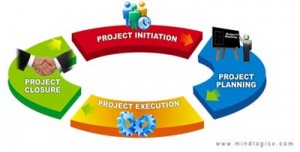Project Management Methodologies
There’s an overwhelming choice of different project management methodologies. Knowing which ones will work best for you can be as challenging as the project itself.
Think of project management (PM) methodologies as blueprints, step-by-step instructions that guide your team on how to build a successful project. With so many different – and in some cases, overlapping – approaches to managing the complexities of any given program, how can you know which one is right for your project, team or organization?
Some of the key Project Management methodologies are:
- Agile was developed for projects requiring significant flexibility and speed and is comprised of “sprints” – short delivery cycles. Agile may be best-suited for projects requiring less control and real-time communication within self-motivated team settings. Agile is highly iterative, allowing for rapid adjustments throughout a project.
- Waterfall methodology is sequential in nature; it’s used across many industries, most commonly in software development. It’s comprised of static phases (requirements analysis, design, testing, implementation and maintenance), executed in a specific order. Waterfall allows for increased control throughout each phase but can be highly inflexible if scope changes may be anticipated later.
- Critical Path Method (CPM) is a step-by-step methodology used for projects with interdependent activities. It contains a list of activities and uses a work-break-down structure (WBS), a timeline to complete and dependencies, milestones and deliverables. It outlines critical and non-critical activities by calculating the “longest” (on the critical path) and “shortest” (float) time to complete tasks to determine which activities are critical and which are not.
- Critical Chain Project Management (CCPM) differs from Critical Path Method (CPM) in that it focuses on the use of resources within a project instead of project activities. To address potential issues with resources, buffers are built in to ensure projects are on-time and that safety is not compromised.
- Six Sigma was originally developed by Motorola to eliminate waste and improve processes and profits. It is data-driven and has three key components: DMAIC (define, measure, analyze, improve and control) DMADV (define, measure, analyze, design and verify) and DFSS (which stands for “Design for Six Sigma” and can include the previous options, as well as others, like IDOV – identify, design, optimize and verify). Six sigma is sometimes debated as a methodology in the PM community.
- Scrum (named after rugby) is a part of the agile framework and is also iterative in nature. “Scrum sessions” or “30-day sprints” are used to determine prioritized tasks. A Scrum Master is used to facilitate instead of a Project Manager. Small teams may be assembled to focus on specific tasks independently and then meet with the Scrum Master to evaluate progress or results and reprioritize backlogged tasks.
There are also several other methodologies like Event Chain Methodology (ECM), Crystal, FDD (Feature Driven Development), DSDM (Dynamic Systems Development), Adaptive Software Development and RUP (Rational Unified Process), Lean Development (LD) PRINCE2 and others.
Good, better, best?
While there is no “best” methodology that works for all business types, sizes or industries, there are ways to determine which methodology to use and how to effectively apply it. When evaluating methodologies, these are only a few of the many factors that should be carefully considered:
- Organizational strategic goals and core values
- Key business drivers
- Constraints
- Stakeholders
- Risks
- Complexity
- Project size & cost
To assist in this regard, the Project Management Institute (PMI) developed the Organizational Project Management Maturity Model (OPM3) – now a globally recognized standard – to enable organizations to identify, measure and improve PM capabilities, standardize processes, help solidify successful project outcomes and ultimately determine best practices and strengthen the connection between strategic planning and execution. OPM3 focuses on overall organizational strategic effectiveness and incorporates project, program and portfolio management. This standard was updated in 2008 and again in 2013 and is recognized by the American National Standards Institute (ANSI) as an American National Standard.
In their Implementing Organizational Project Management Practice Guide, the PMI discusses some high-level processes for tailoring PM methodologies. Organizations should carefully evaluate which methodologies work for various projects based on factors in the PMI Methodology Tailoring Process in order to maximize strategic benefits.
Benefits of Organizational Project Management (OPM)
OPM3 is aimed at achieving successful strategic alignment. And since successful project outcomes depend heavily on such alignment, it may make sense for your business to adopt OPM3. Organizations will need include EPMOs (Enterprise Program Management Offices) in high-level planning sessions in order to ensure the right methodologies are deployed for specific projects to increase productivity and customer satisfaction, gain a competitive advantage, improve cost control and communications and predict performance. Ultimately, this will improve and expedite decision making as well as support alignment with company-wide goals.
Different PM methodologies have their strengths and weaknesses; organizations may want to consider selecting multiple project management methodologies based on the project and other factors previously mentioned (among others)…and also develop some standardized best practices that can be tweaked as various factors change.
The key is to figure out how specific projects align with the over-all organization objectives, and, once you determine what factors impact the success or failure of those goals, find the most suitable methodologies that will enable your organization to effectively and efficiently reach the desired business result.


